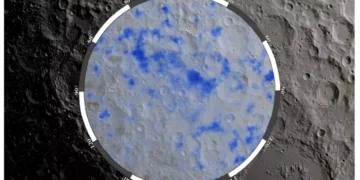Imagine a future where humans not only visit the Moon but live there, relying on its resources to sustain life. This vision is becoming more tangible with a groundbreaking discovery by Chinese scientists who have developed an innovative method to extract water from lunar soil. This breakthrough could revolutionize lunar exploration and pave the way for permanent human settlements on the Moon.
The Science Behind the Discovery
The Moon has long been considered a barren, waterless desert. Early missions like Apollo brought back samples that seemed to confirm this. However, subsequent missions, such as Cassini and Chandrayaan-1, detected signs of water-bearing minerals, especially near the poles. Despite these findings, extracting water from the Moon remained a significant challenge.
Enter the Chinese research team led by Professor Wang Junqiang. Utilizing samples from the Chang’e-5 mission, which landed in a hydrogen-rich area of the Moon, the team developed a method that combines lunar regolith (the layer of loose, heterogeneous material covering solid rock) with solar wind-implanted hydrogen. By heating the lunar regolith to over 1,200 K using specially designed concave mirrors, they were able to produce water vapor, which was then condensed into liquid water. This method could generate 51 to 76 kilograms of water from one ton of lunar soil—enough to support the daily needs of approximately 50 astronauts.
Why Is This Important?
The implications of this discovery are profound. Water is not only essential for drinking but also for producing oxygen and hydrogen through electrolysis, which can be used for breathing and as a fuel source. This capability could drastically reduce the need for resupply missions from Earth, making long-term lunar habitation more feasible and cost-effective. Moreover, the water could be used to grow plants, supporting sustainable food production on the Moon.
But the benefits extend beyond mere survival. The ability to extract water on the Moon could transform our approach to space exploration. With a reliable source of water, lunar bases could serve as launch points for missions deeper into the solar system, including Mars.
What Makes This Method Special?
Several factors set this method apart from previous attempts to extract water from lunar soil. First, it leverages the natural properties of ilmenite, a mineral abundant on the Moon. Ilmenite’s lattice structure allows it to trap hydrogen from solar winds, which can then be released and combined with oxygen from the regolith to form water. This process is not only efficient but also highly scalable, making it a viable option for large-scale water production on the Moon.
Another key advantage is the use of solar-powered heating. By utilizing the Sun’s energy, the process becomes more sustainable and less reliant on Earth-based resources. This aligns with the broader goal of in-situ resource utilization (ISRU), which aims to use materials found on other celestial bodies to support human activities. ISRU is critical for reducing the costs and risks associated with space exploration, making this method a significant step forward.
The Road Ahead
While the discovery is a major milestone, there are still challenges to overcome before we can fully realize its potential. The technology needs to be tested and refined in the harsh lunar environment, and there are logistical hurdles to establishing a permanent presence on the Moon. However, the groundwork has been laid, and the possibilities are exciting.
China’s plans to establish a lunar research station by 2035, in collaboration with Russia, could serve as a testing ground for this technology. If successful, it could lead to the development of self-sufficient lunar colonies and eventually serve as a blueprint for similar efforts on Mars.
The race for lunar resources is intensifying, with various nations and private companies vying to stake their claim. As this new method demonstrates, the Moon holds untapped potential that could revolutionize not only space exploration but also our understanding of resource management and sustainability.
As we look to the stars, each new discovery adds another piece to the puzzle, bringing us closer to our dream of becoming a multi-planetary species. The Moon, once seen as a desolate wasteland, may soon become a bustling hub of human activity, thanks to the groundbreaking work of scientists pushing the boundaries of what is possible.
Reference:
Wang, J., et al. (2024). “Massive Water Production from Lunar Ilmenite through Reaction with Endogenous Hydrogen.” The Innovation.



















